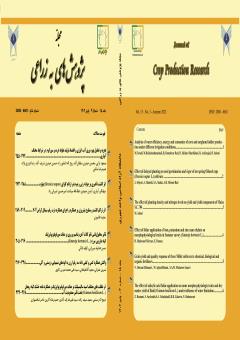Grain yield and quality response of three Millet cultivars to chemical, biological and organic fertilizers
Subject Areas : Crop Production ResearchNasrin Omrani 1 , مجید آقا علیخانی 2 , Seyed Alimohammad Modarres Sanavi 3
1 - Former M.Sc. Student, Tarbiat Modares University, Tehran, Iran.
2 - دانشگاه تربیت مدرس دانشکده کشاورزی
3 - Professor, Faculty of Agriculture, Tarbiat Modares University, Tehran, Iran.
Keywords: Bastan, KCM2, Nitrogen, Nitroxin, Pishahang,
Abstract :
In order to study the effect of different sources of nitrogen fertilization on forage and grain yield of three millet cultivars, an experiment was done at Agricultural Research Station of Tarbiat Modarres University during the spring and summer 2019. Experimental treatments were arranged in split plots based in randomized complete blocks design with three replications. In this experiment four nutrition systems including: 100% chemical nitrogen (urea), 100% organic (vermicompost), integrative nutrition-1 (50% vermicompost + 50% urea) and integrative nutrition-2 (50%vermicompost + 50% urea) were located in the main plots and three millet cultivars (Pishahang, KCM2 and Bastan) in sub plots. Different traits such as grain yield, yield components, biomass, harvest index, grain and forage quality indices were investigated. Results indicated to significant effect of nutritional systems on harvest index, thousand grain weight, grain yield and biological yield. Regarding to the means comparison of fertilizer × cultivar interaction the highest grain yield (2830 kg/ ha) and the lowest one (1217.75 kg per hectare) were obtained from the Bastan and KCM2 cultivars respectively. Pishahang and KCM2 cultivar (both common millet) for important traits such as grain and forage yield and quality were in the same statistical group with the superior treatment (urea) under vermicompost and integrated (vermicompost + urea) treatment. While Bastan cultivar (foxtail millet) produced superior grain and forage yield under integrative (nitroxin + urea) treatment. Therefore, using this treatment in small grain millet production, alternating the 50% of chemical nitrogen fertilizer with the biological fertilizer, nitroxin, the acceptable grain and forage yield will produce and we will one step closer to the goals of sustainable agriculture.


